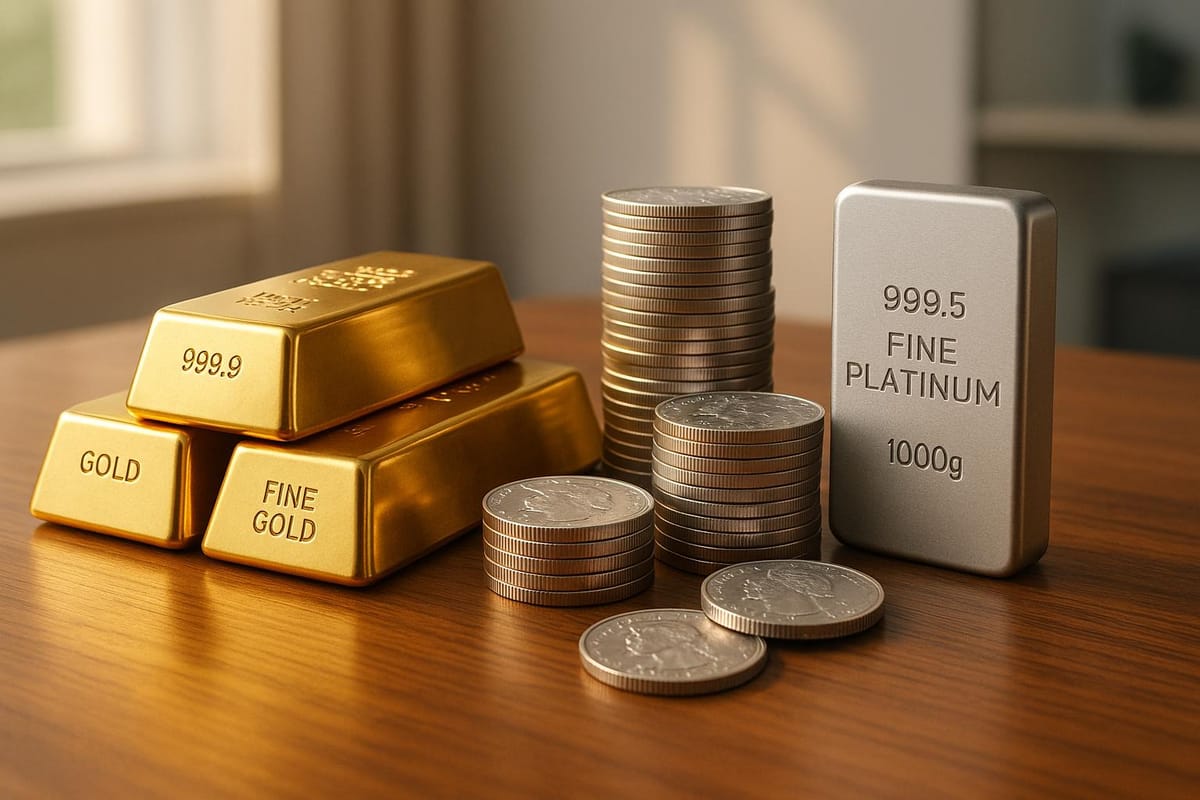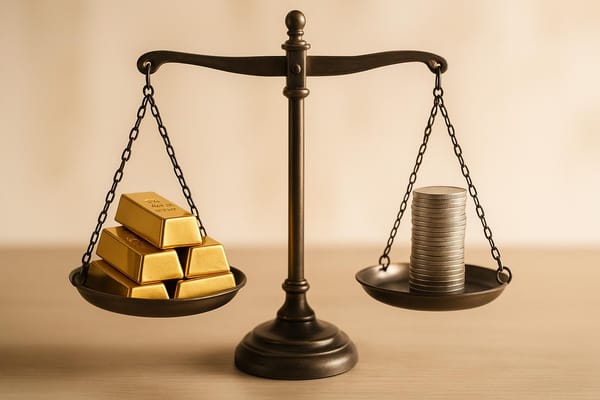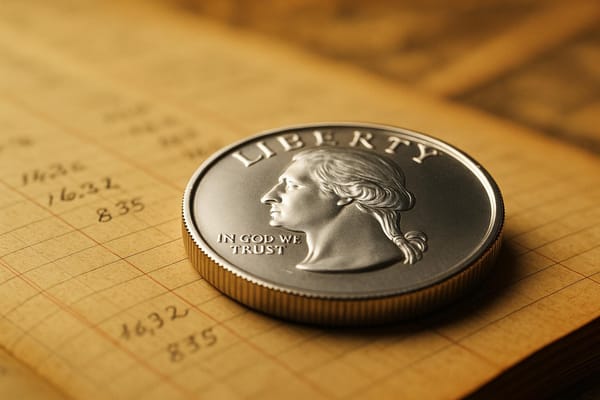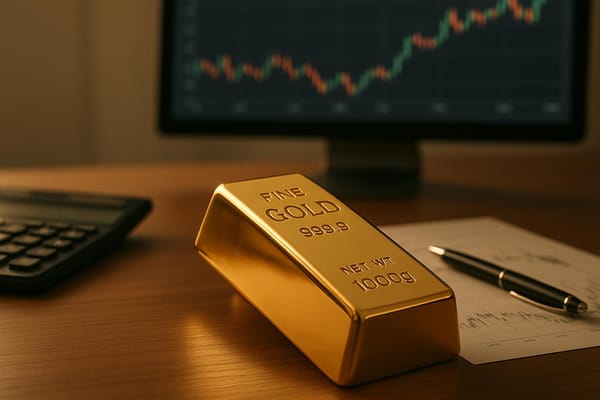Precious Metals FAQ: Top 15 Investor Questions
Explore the essentials of investing in precious metals, including benefits, risks, and various methods to diversify your portfolio.

Precious metals like gold and silver are trusted for their stability, especially during economic uncertainty. Here’s why they remain a popular choice for investors:
- Hedge Against Inflation: Gold maintains value even when currencies weaken. For example, during the 2008 financial crisis, gold prices surged from $872 to $1,900 per ounce.
- Record Highs: In 2025, gold hit $2,911.30 per ounce, and silver saw a 24% price increase in the same year.
- Central Bank Demand: Over 1,000 metric tons of gold were purchased by central banks in 2023, the highest in 50 years.
Investment Options
- Physical Metals: Direct ownership through bars or coins.
- ETFs: Liquid and easy to trade, with lower costs.
- Mining Stocks: Indirect exposure but higher volatility.
- Closed-End Funds: May offer tax benefits.
- Digital Metals: Convenient but carry counterparty risks.
Key Trends in 2025
- Gold exceeded $3,500 per ounce, while silver surpassed $36 per ounce.
- The U.S. Precious Metals Price Index rose 35.26% year-over-year.
- Silver demand is growing due to its use in renewable energy and electronics.
Quick Comparison: Investment Methods
| Method | Liquidity | Storage Required | Counterparty Risk | Costs | Tax Rate | Volatility |
|---|---|---|---|---|---|---|
| Physical Metals | Low | Yes | None | 0.3%-0.75% | Up to 28% | Low |
| ETFs | High | No | Yes | 0.25%-0.40% | Standard Rates | Moderate |
| Mining Stocks | High | No | Yes | Varies | Standard Rates | High |
| Mutual Funds | Moderate | No | Yes | Higher Fees | Standard Rates | Moderate |
Investing in precious metals offers diversification and a hedge against market instability. Choose the method that aligns with your goals, risk tolerance, and timeline.
Gold or Silver: Common Questions from New Precious Metal Investors
Basic Principles of Precious Metals Investing
Understanding how precious metals work can help you fine-tune your investment strategy and aim for long-term success. These assets stand apart from traditional investments, offering distinct characteristics when you grasp their mechanics.
Value and Market Behavior
The prices of precious metals are influenced by a mix of economic trends, global events, and central bank policies, all of which revolve around the balance of supply and demand.
Supply and demand play a key role in shaping precious metal prices. For example, the silver market is expected to remain in a supply deficit for the fifth year in a row. This is largely due to its strong industrial use in renewable energy and electronics, keeping silver prices around $32 per ounce. On the supply side, mining disruptions - caused by strikes, regulatory changes, or natural disasters - can reduce availability and drive prices higher. Similarly, gold recently traded at approximately $2,915 per ounce, reflecting tight supply and strong demand from investors.
Interest rates and currency shifts also have a big impact. Gold and silver tend to move in the opposite direction of the U.S. dollar. When the dollar weakens, these metals often rise in value. Keeping an eye on Federal Reserve decisions, inflation trends, and interest rates can help you anticipate price changes.
Geopolitical tensions and economic indicators like inflation, GDP, and employment rates also play a role. During uncertain times, investors often turn to precious metals as a safe haven, which can push prices higher. For instance, gold demand is traditionally dominated by the jewelry sector, accounting for about 50% of annual consumption. However, investment demand can shift this balance. As of the first quarter of 2025, SPDR Gold Shares ETF (GLD) and its lower-cost counterpart GLDM collectively held over 31.6 million ounces of gold, valued at more than $90 billion.
These factors underscore how precious metals can provide diversification benefits for a portfolio.
Diversification Benefits
Between 2003 and 2025, precious metals captured 50.7% of the gains in global equities while limiting downside exposure to just 14.4%. They also demonstrated a lower correlation to equities (0.25) compared to commodities (0.51), achieving annualized returns of 9.39%, far outpacing the 1.13% seen in commodities.
What makes precious metals particularly effective for diversification is their varied demand drivers. During economic growth, pro-cyclical factors like jewelry and industrial applications tend to increase demand. Meanwhile, during economic slowdowns, investment demand often rises. For instance, silver is more volatile than gold but benefits from consistent industrial demand in sectors like renewable energy and electronics. Since the 2008 financial crisis, diversification has become more challenging, making a basket of precious metals more reliable than relying on just one. Additionally, the push for green technologies is boosting the appeal of metals like platinum, palladium, and silver.
Once your portfolio is balanced, the next step is securing these investments.
Storage and Security Options
How you store your precious metals can significantly impact their safety and accessibility.
Professional storage services offer robust security measures. Storage expert Grant Henson advises:
"I highly advise against storing the metals in your home as this poses a significant risk; a break-in could compromise your assets. I'm a strong advocate for precious metal storage through professional services, as it ensures the safety of your investment."
Depositories specifically designed for precious metals provide advanced security features such as climate-controlled environments, surveillance systems, and restricted access. These facilities often offer two storage options: segregated and non-segregated. Segregated storage ensures your metals are kept separate from others, meaning you get back exactly what you deposited. This option also provides clear audit trails and eliminates the risk of receiving "like-kind" replacements.
The cost of storage varies depending on the provider and services. On average, vault storage fees range from 0.3% to 0.75% of the total value of stored gold. Some providers, like Money Metals Exchange, charge less than 0.49%, which includes "all-risks" insurance.
Here’s a quick comparison of major storage providers:
| Provider | Annual Fee | Minimum Fee | Special Features |
|---|---|---|---|
| GoldSilver | 0.6% of asset value | $4 monthly | Private vault storage |
| Sprott Money | 0.35% (under $5M) | 16.67 CAD monthly | Discounts for larger accounts |
| Texas Precious Metals Depository | 0.5% (gold), 0.6% (silver) | N/A | Focus on precious metals |
| Blue Vault (San Diego) | Varies | $15 monthly | Low-cost option |
| Texas Bullion Depository | Varies | $25 quarterly | Established reputation |
Bank safe deposit boxes are another option, though they come with limitations. Restricted access hours and the lack of FDIC insurance for precious metal contents are notable downsides. Additionally, some banks may not allow precious metals in their safe deposit boxes.
Insurance is another essential consideration. Comprehensive coverage should protect against theft, damage, and other risks. Most professional storage services include insurance in their fees, but it’s wise to confirm the coverage terms and limits beforehand.
Geography can also influence your storage decision. Offshore storage is sometimes chosen for added security against potential capital controls, while domestic storage offers easier access and fewer regulatory challenges for U.S. investors.
When selecting a storage provider, it’s important to research their reputation. Look for customer feedback on platforms like Reddit and X, and check for additional services such as quick liquidity options or free shipping. Avoid storing precious metals with the dealers you purchase from, as this can create conflicts of interest and risks of mismanagement. Independent, third-party depositories are generally the safest option.
Comparing Precious Metals Investment Methods
When it comes to investing in precious metals, there are several options to consider. Each approach has its own advantages and drawbacks, so understanding what aligns best with your financial goals and circumstances is crucial. Let’s dive into the differences between holding physical metals and investing in ETFs, as well as explore alternatives like mining stocks and mutual funds.
Physical Metals vs. ETFs
Deciding between owning physical gold or silver and investing in exchange-traded funds (ETFs) often boils down to the trade-off between control and convenience.
Physical metals give you direct ownership of a tangible asset. When you hold gold or silver in physical form, it exists outside the digital financial system and doesn’t rely on intermediaries. Historically, these assets have retained value over time and shown minimal correlation with traditional investments like stocks and bonds. They also act as a hedge against inflation and currency instability. However, owning physical metals comes with challenges. Selling them can be cumbersome, and transaction fees, along with storage and insurance costs, can eat into your returns.
ETFs, on the other hand, offer unmatched liquidity and ease of trading. You can buy or sell shares of gold ETFs on stock exchanges just like any other stock, making them a flexible option for quick transactions. For example, the SPDR Gold Shares ETF had an expense ratio of 0.40% as of mid-2024. Additionally, ETFs typically have lower costs compared to the expenses involved in safely storing and insuring physical gold. For those starting small, ETFs can be an accessible entry point - especially considering that gold was trading at $2,390 per ounce as of July 26, 2024.
That said, ETFs come with their own risks. Since they are managed by financial institutions, there’s a degree of credit risk involved, and investors don’t have the option to take physical possession of the metal. Over time, management fees can also chip away at returns. Tax considerations differ too - while ETFs are taxed at standard capital gains rates, physical gold is classified as a collectible by the IRS and may face a higher maximum tax rate of 28%.
If direct ownership doesn’t suit your needs, there are other ways to gain exposure to precious metals, such as through mining stocks or mutual funds.
Mining Stocks and Mutual Funds
Mining stocks and mutual funds provide indirect ways to invest in precious metals, each with its own set of risks and potential rewards.
Gold mining stocks allow you to benefit from rising gold prices without physically owning the metal. These stocks often provide leverage - meaning their value can increase more significantly when gold prices rise - and some even pay dividends. However, their performance can vary widely. From 2013 to 2023, gold prices rose by about 55%, yet the GDX ETF, which tracks gold miners, gained only 12%. Over the past five years, gold prices jumped 95%, while Newmont Corporation, one of the largest gold miners, increased just 1.6%, and Barrick Mining Corporation saw an 11% loss. This disconnect happens because mining stocks are influenced by factors like labor costs, fuel prices, political risks, and individual company performance. They also tend to be more volatile and correlate more closely with the broader stock market. For instance, in the last year, the VanEck Gold Miners ETF (GDX) exhibited a volatility of 34.34%, compared to physical gold’s 14.2%. Additionally, while physical gold (via the SPDR Gold Shares ETF) has a beta of 0.3, indicating low correlation with the market, GDX’s beta is closer to 0.9.
Mutual funds that focus on precious metals offer diversified exposure to the sector. However, they typically come with higher management fees and are traded only at the market’s close, unlike ETFs, which can be traded throughout the day.
Here’s a quick comparison of the different methods:
Investment Method Comparison Table
| Investment Method | Liquidity | Storage Required | Counterparty Risk | Typical Annual Costs | Tax Treatment | Volatility Level |
|---|---|---|---|---|---|---|
| Physical Metals | Limited | Yes | None | 0.3%–0.75% storage fees | Up to 28% capital gains | Low to Moderate |
| Gold/Silver ETFs | High | No | Yes | 0.25%–0.40% expense ratios | Up to 28% capital gains | Low to Moderate |
| Mining Stocks | High | No | Yes | Varies by stock | Standard capital gains rates | High |
| Precious Metals Mutual Funds | Moderate | No | Yes | Higher than ETFs | Standard capital gains rates | Moderate to High |
When choosing an investment method, think about your timeline and appetite for risk. Physical metals might be the right fit if you’re looking to preserve wealth over the long term and want full control over your assets. ETFs, with their liquidity and lower costs, are ideal for those who value convenience and want to invest smaller amounts regularly. For investors comfortable with volatility and seeking potential upside, mining stocks can offer opportunities tied to gold price movements.
The key is to align your investment choice with your financial goals, risk tolerance, and overall portfolio strategy.
Risk Management and Best Practices
Investing in precious metals can be rewarding, but it’s not without its challenges. Like any investment, it carries risks that require thoughtful management. A solid understanding of these risks and following smart strategies can help protect your investment and improve your chances of success.
Understanding Risks and Rewards
When it comes to precious metals, market volatility is one of the most significant risks. Prices for gold, silver, and platinum can swing dramatically based on global economic conditions, interest rate changes, and currency fluctuations. For example, gold hit a high of $2,505.54 per ounce in August 2024. Beyond price swings, owning physical metals introduces risks like theft or damage. To address this, many investors choose professional storage services, such as The Vault® by The Royal Mint, though these services come with added costs.
Liquidity is another factor to consider. Physical metals, like bullion, can typically be sold quickly through reputable dealers, while digital investments like ETFs offer even greater ease of sale but come with counterparty risks. Scams and fraudulent schemes are also a concern in this market. To minimize these risks, keep an eye on market trends, use tools like stop-loss orders, and ensure your investments are insured.
Given these risks, working with reputable dealers is essential for safeguarding your investments.
Choosing Reputable Dealers
Finding a trustworthy dealer is one of the most critical steps in precious metals investing. Start by checking for key credentials. Look for dealers who are members of the Professional Numismatists Guild (PNG), affiliated with the American Numismatic Association (ANA), accredited by the Better Business Bureau (BBB), or recognized as Authorized Purchasers by the US Mint.
"Applicants [must] have at least five years of experience as a professional numismatist, a clean ethical record and offer return privileges for misrepresented items", says Brandon Aversano, CEO of The Alloy Market.
"There aren't many credentials with real weight [in this] loosely regulated industry, but [being] an Authorized Purchaser with a US Mint is a strong indicator of legitimacy", adds Brett Elliott, marketing director at American Precious Metals Exchange.
It’s also a good idea to verify the dealer’s business registration and history through your state’s Secretary of State website, as some scammers frequently rebrand. Customer reviews are another valuable resource - 91% of consumers check reviews before making a purchase. Dealers like American Hartford Gold and APMEX consistently receive high ratings, which can provide peace of mind. Lastly, ensure the dealer offers transparent pricing and clear policies on returns, buybacks, and secure shipping.
Once you’ve identified a reliable dealer, the next step is to determine how precious metals fit into your overall portfolio.
Portfolio Allocation Guidelines
Balancing your portfolio to include precious metals is key to achieving your financial goals. The right allocation depends on your individual risk tolerance and investment strategy. Many financial advisors suggest dedicating 5% to 15% of your portfolio to precious metals as a way to diversify and hedge against economic uncertainty. Expert recommendations vary, with some suggesting as little as 3% and others going up to 20%.
Research from the World Gold Council shows that even a modest 5% allocation to gold can enhance a portfolio’s Sharpe ratio by 12% while reducing overall volatility. Your ideal allocation may also depend on your investment style. For example:
- Conservative investors (often aged 55 or older) might stick to 5–10%.
- Balanced investors (ages 35–55) could aim for 7–12%.
- Aggressive investors (under 35) might allocate 10–15%, with some strategies reaching up to 20%.
If your portfolio leans heavily toward stocks, adding precious metals can provide valuable diversification, especially during periods of inflation or market instability. For instance, the SPDR Gold Shares ETF has delivered a 23.7% year-to-date return, compared to just 0.4% for the SPDR S&P 500 ETF.
A gradual approach is often recommended - build your position over 6–12 months and rebalance quarterly or whenever your allocation drifts 2–3% from your target. For larger or more complex portfolios, consulting a financial advisor can provide additional guidance.
Conclusion
Precious metals have long been a reliable way to diversify and protect wealth, particularly during times of economic uncertainty. With global gold demand up 8% year-over-year and investment demand climbing 12% amid market turbulence, their appeal remains strong.
Key Points Summary
Precious metals stand out for their ability to diversify portfolios beyond traditional assets. They offer protection against inflation, carry no credit risk, and often have a low or negative correlation to stocks and bonds. As financial educator Robert Kiyosaki puts it:
"Commodities such as gold and silver have a world market that transcends national borders, politics, religions, and race".
Diversifying is critical for portfolio stability. Gold acts as a tangible "savings account", while silver, being more affordable, is a great starting point for smaller investors. Even a small allocation can make a noticeable difference - consider the Precious Metals Price Index, which increased from 181.41 to 245.37 between April 2024 and April 2025.
However, risk management is just as important. While precious metals can help grow wealth, their volatility requires careful planning. For instance, central banks recently purchased 337 tons of gold, showcasing institutional confidence. But individual investors need to focus on working with trustworthy dealers and understanding storage options to avoid unnecessary risks.
Strategic allocation is key. Most financial advisors recommend dedicating 5-10% of an investment portfolio to precious metals, though individual circumstances might call for adjustments. Using dollar-cost averaging can help manage price fluctuations.
Next Steps for Investors
With these insights in mind, the next step is to define your investment approach. Are you aiming for long-term wealth preservation or active trading? This decision will shape everything from your choice of investment vehicle to your risk management plans.
Education and research are the backbone of successful investing. Ken Bowers, Owner of The Quarter Smith, highlights the importance of preparation:
"Investing in precious metals can be a smart financial decision, but it's important to do your homework. Understanding the value of what you're buying is key to making a sound investment".
Stay informed about factors influencing precious metals prices, such as economic data, geopolitical developments, and market trends.
Start small and build over time. Begin with a modest allocation to learn the ropes, then expand your position as you gain confidence. Diversify across different metals, product types, and sizes to strengthen your strategy. For many, investing in precious metals is a practical way to safeguard and grow wealth during uncertain times.
Finally, combine disciplined risk management with a well-rounded strategy to ensure long-term portfolio resilience. Seek advice from financial professionals experienced in precious metals investing. They can help you navigate tax considerations, liquidity challenges, and the various investment options available.
The precious metals market rewards those who are informed, patient, and prepared. With the right research, planning, and execution, precious metals can play a valuable role in building and protecting your wealth for the future.
FAQs
What factors impact the prices of precious metals like gold and silver?
The prices of precious metals like gold and silver are shaped by a mix of economic trends, global events, and industrial demand. Economic factors such as inflation, interest rates, and central bank policies play a major role. For instance, gold often gains appeal as a safe-haven asset during economic uncertainty or when the US dollar weakens.
Geopolitical events and market sentiment are equally influential. Political tensions or instability can push investors toward gold as a secure store of value. Meanwhile, silver prices are heavily affected by industrial demand and supply dynamics. Since silver is essential in industries like electronics and solar energy, advancements in technology or supply shortages can lead to noticeable price swings.
In short, the interplay between these factors drives the market for gold and silver, influencing their value in different ways.
What’s the safest way to store my physical precious metals?
Choosing how to store your physical precious metals comes down to weighing security, accessibility, and cost. One common option is using third-party depositories, which are known for their top-notch security measures. These facilities often feature 24/7 surveillance, armed guards, and insurance coverage, giving you peace of mind that your investment is well-protected.
Alternatively, you might consider a safe deposit box at a bank. This option provides a secure environment and relatively easy access, though it may involve extra fees and often comes with limited insurance.
Your choice should reflect what matters most to you - whether that’s the highest level of security, convenient access, or keeping costs low. Pick the storage solution that best fits your priorities.
What’s the difference between investing in physical precious metals and ETFs, and how do I choose the best option for me?
Investing in physical precious metals like gold or silver bullion means holding a tangible asset in your hands. This approach offers a sense of security and direct ownership, making it appealing to those who want something they can physically possess. However, owning physical metals also comes with extra responsibilities, such as finding secure storage and paying for insurance. It’s often a go-to option for those aiming to protect their wealth over the long term, especially during times of inflation or economic instability.
On the flip side, ETFs (Exchange-Traded Funds) provide a way to invest in precious metals without the need to physically own them. These funds trade on the stock market, offering greater liquidity and lower transaction costs. For investors who value convenience and quick portfolio diversification, ETFs are a practical alternative.
Choosing between the two boils down to your goals. If having a tangible asset and long-term security is your priority, physical metals might be the way to go. But if you’re after flexibility, ease of trading, and lower upfront costs, ETFs could be a better fit.



